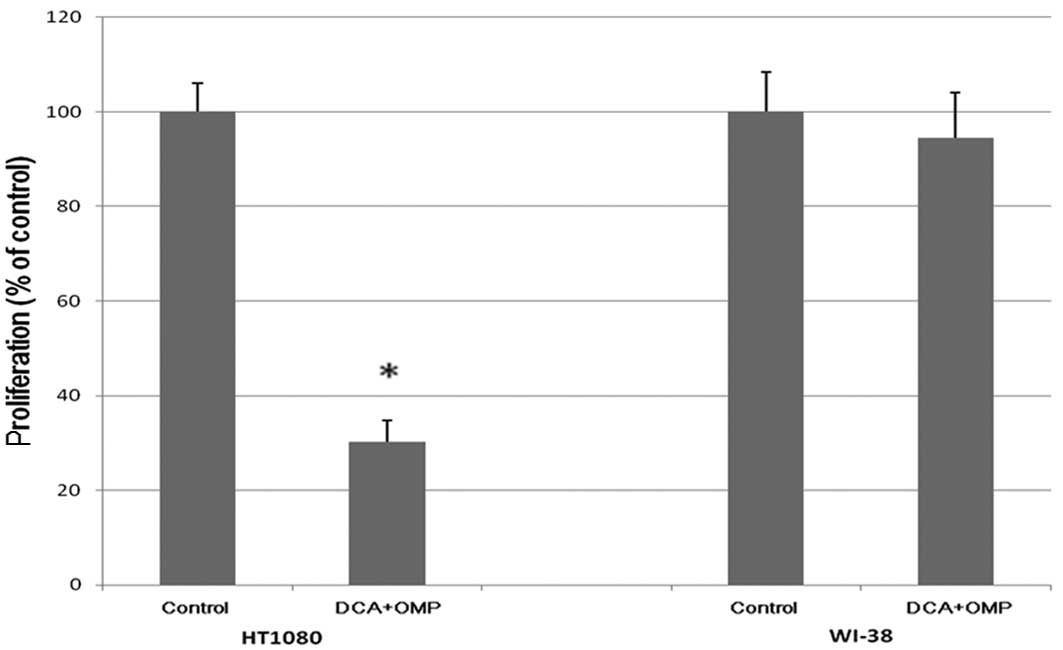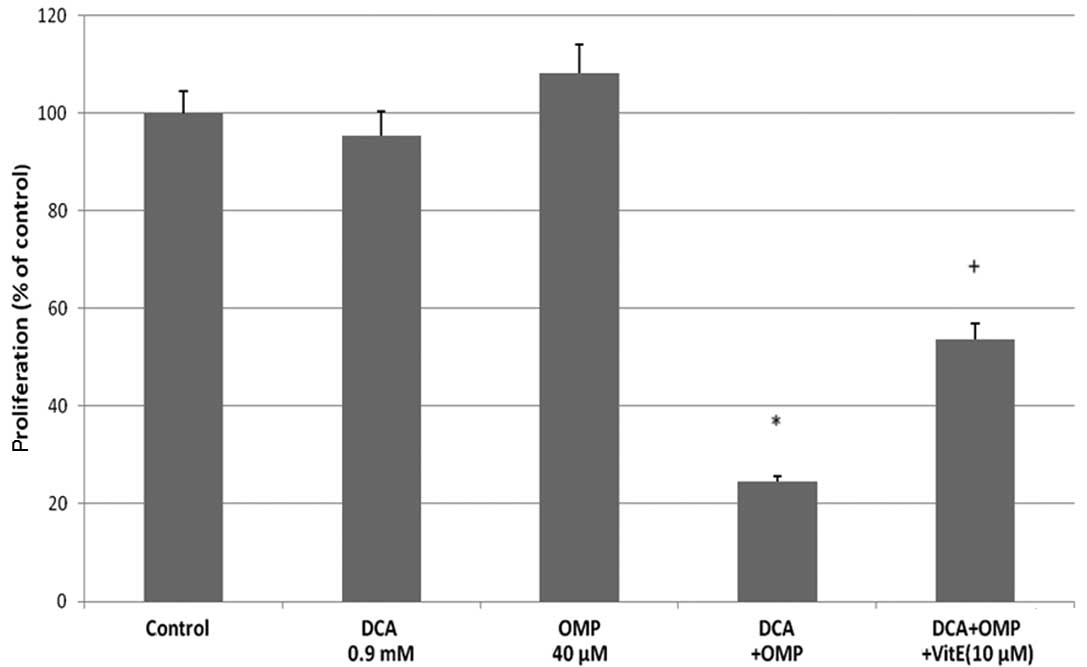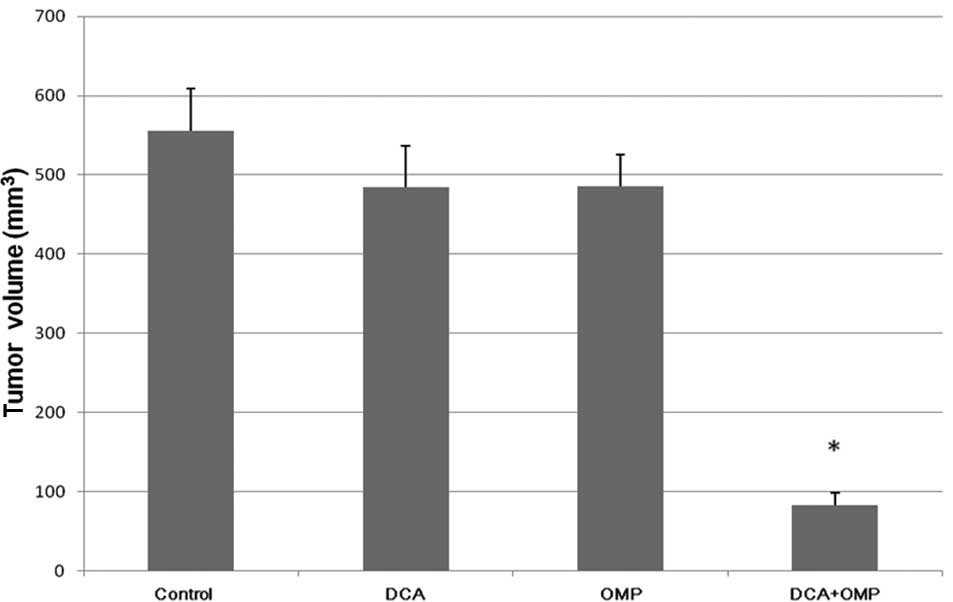Cotreatment with dichloroacetate and omeprazole exhibits a synergistic antiproliferative effect on malignant tumors
- Authors:
- Published online on: January 3, 2012 https://doi.org/10.3892/ol.2012.552
- Pages: 726-728
Abstract
Introduction
Warburg first observed that even in the presence of sufficient oxygen, cancer cells prefer to metabolize glucose and produce lactic acid (1–4). The concomitant increase in glucose uptake may be exploited clinically for the detection of most solid malignant tumors by fluorodeoxyglucose positron emission tomography (FDG-PET). One possible reason for cancers adopting this less efficient pathway for producing adenosine triphosphate (ATP) compared with oxidative phosphorylation is its advantage for survival and proliferation in the unique hypoxic tumor environment (5). This preference for anaerobic respiration is also considered to be the reason for the resistance cancer cells exhibit to anticancer drugs which induce apoptosis via the mitochondrial pathway. Bonnet et al have reported that treating cancer cells with dichloroacetate (DCA), an approved treatment for congenital lactic acidosis, reverses the Warburg effect and inhibits tumor growth (3,4,6–8). DCA increases the flux of pyruvate into the mitochondria by inhibiting the pyruvate dehydrogenase kinase and promotes glucose oxidation over glycolysis. As a result, DCA decreases the production of lactic acid by the tumor and increases the intracellular pH. DCA induces apoptosis via two pathways, one in the mitochondria, where depolarization and superoxide (SOD) production activates mitochondria-dependent apoptosis, and the other at the plasmalemmal level, where activation/upregulation of Kv1.5 channels decreases the (K+)i, activating caspases (6). DCA is a promising anticancer drug due to the convenience of its oral administration, low cost, few side effects and long experience of clinical use (7,8). Although it appeared to be a promising treatment for malignant tumors, its effect is limited in an ongoing report of clinical trials. Therefore, we aimed to find clinically-used drugs that enhance the effects of DCA.
Omeprazole (OMP) is a proton pump inhibitor (PPI) and is also known to enhance the effects of anticancer drugs (9). OMP inhibits the activity of V-ATPase besides targeting the gastric acid pump. It was reported to inhibit the proliferation of tumor cells, possibly by alkalinization of lysosomes and permeabilization of lysosome membranes, followed by the production of reactive oxygen species (ROS) (10,11).
As described, DCA and OMP are thought to inhibit tumor cell growth through the common pathway of ROS production by influencing the intracellular pH levels. Since these two drugs are used clinically with minor side effects, we believe that their combination is a promising protocol for cancer treatment.
Materials and methods
Chemicals
DCA and vitamin E (tocopherol acetate) were purchased from Wako Chemical Industries, Ltd. (Tokyo, Japan). OMP was purchased from Astra Zeneca Japan (Osaka, Japan). Z-VAD-FMK was purchased from the Peptide Institute, Inc. (Osaka, Japan).
Cell culture
HT1080 human fibrosarcoma cells, WI-38 human fibroblast cells and RKO colon cancer cells were seeded and grown in Dulbecco's modified Eagle's medium containing 10% fetal bovine serum (FBS) and maintained in an incubator at 37˚C and 5% CO2. For the cell proliferation experiments, cells were seeded in 12-well plates and incubated under the same conditions. After 7 days, the cells were treated with trypsin-EDTA and counted under a microscope.
Animal experiments
HT1080 cells (5×106) were inoculated subcutaneously into nude mice (8w female). The drugs were added to the drinking water in order to achieve a daily dose similar to that used clinically (DCA 50 mg/kg, OMP 2 mg/kg). The size of each tumor was measured with a caliper and the tumor volume was calculated by the multiplication of three diameters.
Results
Combined treatment of DCA and OMP inhibited cell proliferation
HT1080 human fibrosarcoma cells were cultured with increasing concentrations of DCA and OMP for 7 days, which resulted in a dose-dependent inhibition of proliferation (Fig. 1). As shown in Fig. 2A, the combination of DCA and OMP markedly blocked the proliferation of HT1080 fibrosarcoma cells, while the same combination did not affect the proliferation of WI-38 normal human fibroblast cells.
Vitamin E inhibited the effects of DCA and OMP
Although there has been controversy over the mechanism of the caspase-dependent cell growth inhibition by OMP (10,11), DCA and OMP have been reported to inhibit tumor cell growth through the production of SODs (6,10). To establish whether the same mechanism applied in the HT1080 fibrosarcoma cells, we used vitamin E as an inhibitor of SOD. Vitamin E successfully inhibited the effects of DCA and OMP, thus SOD production was thought to be involved in the inhibition of tumor cell growth (Fig. 2B). The pan-caspase inhibitor Z-VAD-FMK also inhibited the effects of these drugs; therefore a caspase-dependent antitumor mechanism was thought to be involved, at least in part, in these processes (Fig. 2B). Taken together, DCA and OMP inhibit the growth of HT1080 fibrosarcoma cells, possibly through a caspase-dependent pathway by SOD production. As a result, the drugs may exhibit a synergistic effect when combined. This synergistic effect and the inhibitory effect with vitamin E was also observed in RKO colon cancer cells (Fig. 3).
We performed animal experiments to investigate the effects of DCA and OMP in vivo
As shown in Fig. 4, the antitumor effect of the combination of DCA and OMP was also greater than that of either drug alone.
Discussion
We have shown that a combined treatment of DCA and OMP is more effective than treatment with either drug alone in HT1080 human fibrosarcoma cells and RKO colon cancer cells. The combined therapy was also effective in animal experiments.
DCA and OMP have been used safely for a number of years but are not classified as anticancer drugs. DCA has been used to treat congenital metabolic acidosis and OMP has been used to treat acid-related diseases, both without major side effects (7,8,12, 13). The combination of DCA and OMP is expected to reduce the necessary dose of each drug and the accompanying risks.
Oral doses of 20 mg OMP once daily have been reported to lead to a maximum plasma concentration in patients of ~2.5 μg/ml (7 μM) 2 h after administering the dose (14). A dose of 120 mg OMP three times a day has been used for the treatment of Zollinger-Ellison syndrome, with only rare and mild side effects even following long-term use (15,16). This dose corresponds with a hypothetical in vivo peak concentration of ~15 μg/ml (42 μM). Overdoses of up to 2,400 mg [a hypothetical plasma peak concentration of 300 μg/ml (840 μM)] have been tolerated with minor side effects (17). DCA is already established in clinical practice. The Cmax value of DCA in adults following 6 months of continuous treatment (oral doses of 25 mg/kg/day) was 53±18 μg/ml (0.35±0.12 mM) (18). Patients were safely treated chronically with DCA at the maximum dose of 50 mg/kg/day (19). A number of children with lactic acidosis were administered >100 mg/kg DCA daily for a long period (8). From these data we consider that the necessary dose of the two drugs is tolerable. Moreover, candidate analogs of DCA with less toxicity and better binding affinity have been developed (20). Thus, the combination of DCA and OMP is considered a potential therapeutic option for malignant tumors and may lead to the development of a new therapeutic strategy.
Abbreviations:
|
DCA |
dichloroacetate |
|
PPI |
proton pump inhibitor |
|
OMP |
omeprazole |
|
SOD |
superoxide |
|
ROS |
reactive oxygen species |
References
|
Warburg O: Ueber den Stoffwechsel der Tumoren. Constable; London: 1930 | |
|
Warburg O: On the origin of cancer cells. Science. 123:309–314. 1956. View Article : Google Scholar : PubMed/NCBI | |
|
Hsu PP and Sabatini DM: Cancer cell metabolism: Warburg and beyond. Cell. 134:703–707. 2008. View Article : Google Scholar : PubMed/NCBI | |
|
Michelakis ED, Webster L and Mackey LR: Dichloroacetate (DCA) as a potential metabolic-targeting therapy for cancer. Br J Cancer. 99:989–994. 2008. View Article : Google Scholar : PubMed/NCBI | |
|
Plas DR and Thompson CB: Cell metabolism in the regulation of programmed cell death. Trends Endocrinol Metab. 13:75–78. 2002. View Article : Google Scholar : PubMed/NCBI | |
|
Bonnet S, Archer SL, Allalunis-Turner J, Haromy A, Beaulieu C, Thompson R, Lee CT, Lopaschuk GD, Puttagunta L, Bonnet S, et al: A mitochondria-K+ channel axis is suppressed in cancer and its normalization promotes apoptosis and inhibits cancer growth. Cancer Cell. 11:37–51. 2007. | |
|
Stacpoole PW: The pharmacology of dichloroacetate. Metabolism. 38:1124–1144. 2006. View Article : Google Scholar | |
|
Stacpoole PW, Gilbert LR, Neiberger RE, Carney PR, Valenstein E, Theriaque DW and Shuster JJ: Evaluation of long-term treatment of children with congenital lactic acidosis with dichloroacetate. Pediatrics. 121:1223–1228. 2008. View Article : Google Scholar : PubMed/NCBI | |
|
Luciani F, Spada M, Milito AD, Molinari A, Rivoltini L, Montinaro A, Marra M, Lugini L, Logozzi M, Lozupone F, et al: Effect of proton pump inhibitor pretreatment on resistance of solid tumors to cytotoxic drugs. J Natl Cancer Inst. 96:1702–1713. 2004. View Article : Google Scholar : PubMed/NCBI | |
|
Milito AD, Iessi E, Logozzi M, Lozupone F, Spada M, Marino ML, Federici C, Perdicchio M, Matarrese P, Lugini L, et al: Proton pump inhibitors induce apoptosis of human B-cell tumors through a caspase-independent mechanism involving reactive oxygen species. Cancer Res. 67:5408–5417. 2007. View Article : Google Scholar : PubMed/NCBI | |
|
De Milito A, Canese R, Marino ML, Borghi M, Iero M, Villa A, Venturi G, Lozupone F, Iessi E, Logozzi M, et al: pH-dependent antitumor activity of proton pump inhibitors against human melanoma is mediated by inhibition of tumor acidity. Int J Cancer. 27:207–219. 2010.PubMed/NCBI | |
|
Michelakis ED, Sutendra G, Dromparis P, Webster L, Haromy A, Niven E, Maguire C, Gammer TL, Mackey JR, Fulton D, et al: Metabolic modulation of glioblastoma with dichloroacetate. Sci Trasl Med. 2:31–34. 2010.PubMed/NCBI | |
|
Shi S and Klotz U: Proton pump inhibitors: an update of their clinical use and pharmacokinetics. Eur J Clin Pharmacol. 64:935–951. 2008. View Article : Google Scholar : PubMed/NCBI | |
|
Katagiri F, Inoue S, Itoh H and Takayema M: Omeprazole raises somatostatin and motilin in human plasma. Biol Pharm Bull. 28:370–372. 2005. View Article : Google Scholar : PubMed/NCBI | |
|
Frucht H, Maton PN and Jensen RT: Use of omeprazole in patients with Zollinger-Ellison syndrome. Dig Dis Sci. 36:394–404. 1991. View Article : Google Scholar : PubMed/NCBI | |
|
Thomson ABR, Sauve MD, Kassam N and Kamitakahara H: Safety of the long-term use of proton pump inhibitors. World J Gastroenterol. 16:2323–2330. 2010. View Article : Google Scholar : PubMed/NCBI | |
|
Udelnow A, Kreyes A, Ellinger S, Landfester K, Walther P, Klapperstueck T, Wohlrab J, Henne-Bruns D, Knippschild U and Würl P: Omeprazole inhibits proliferation and modulates autophagy in pancreatic cancer cells. PLoS One. 6:e201432011. View Article : Google Scholar : PubMed/NCBI | |
|
Shroads AL, Guo X, Dixit V, Liu HP, James MO and Stacpoole PW: Age-dependent kinetics and metabolism of dichloroacetate: possible relevance to toxicity. J Pharmacol Exp Ther. 324:1163–1171. 2008. View Article : Google Scholar : PubMed/NCBI | |
|
Stacpoole PW, Henderson GN, Yan Z, Cornett R and James MO: Pharmacokinetics, metabolism and toxicology of dichloroacetate. Drug Metab Rev. 30:499–539. 1998. View Article : Google Scholar : PubMed/NCBI | |
|
Subramanian K and Ramaian AS: Development of a less toxic dichloroacetate analogue by docking and descriptor analysis. Bioinformation. 5:73–76. 2010. View Article : Google Scholar : PubMed/NCBI |













